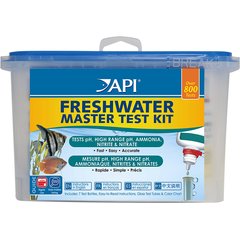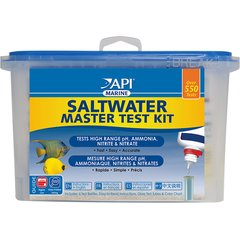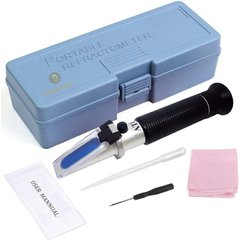Fish Tank Water Testing
Juan Carlos Juarez Jaramillo/iStock / Getty Images Plus via Getty Images
Poor water quality is the leading cause of death in aquarium fish, making it one of the most critical parts of maintaining a tank. A fish tank water test helps detect unwanted waste sooner, which can avoid future health problems.
Why Does Fish Tank Water Need to be Tested?
The water in your fish tank contains many vital components for your fish, but it can also have harmful components. Testing your tank’s water is the only way to accurately tell if your tank’s water is ideal for your fish. Even if the water appears clear and clean with the naked eye, it can still be harmful to your fish.
Depending on the type of tank you keep, the parameters to check with a water test kit may include:
-
pH
-
Ammonia
-
Nitrite
-
Water hardness
-
Chlorine
-
Alkalinity
-
Salinity
-
Calcium
-
Phosphate
There are many risks involved when regular water testing is not performed. For example, too much waste in the water can cause oxygen levels to become depleted. Incorrect pH balance in your fish tank can damage body tissue and even cause the fish to have trouble breathing.
Unfortunately, your fish is more likely to become ill and die suddenly if water quality is not regularly checked.
The Best Aquarium Test Kits
Aquarium test kits are not one-size-fits-all, so some factors need to be considered before choosing the best aquarium test kit that would be best for your tank. The core parameters that should be checked in every tank are:
-
Ammonia
-
Nitrite
-
pH
-
Salinity, if you have a saltwater tank
Every species of fish is different and may have other water parameters that are important to their specific species. Because of this, you may need to buy additional tests based on their needs, such as reef tanks that may require calcium and phosphate checks.
You will typically see two different types of fish tank water tests at the store: strips and liquids. The liquid tests will be the most accurate; however, they can require precision to receive accurate results. Strip tests are not as accurate, but they can be easier for beginner hobbyists to use.
Recommended Products
This fish water test measures nitrates, nitrites, chlorine, hardness, pH, and alkalinity. This product can be used for both freshwater and saltwater aquariums.
Recommended Products
As of the most available freshwater aquarium test kits, the API Aquarium Master measures pH, nitrates, nitrites, and ammonia using reagents. These values are the most important to monitor for a freshwater tank.
Recommended Products
This is also one of the most available saltwater aquarium test kits. It measures pH, nitrates, nitrites, and ammonia using reagents. Additional testing equipment is needed for saltwater tanks to test salinity, alkalinity, calcium, and phosphorus.
Recommended Products
This test accurately measures the salt concentration (or specific gravity) of the water in your fish tank.
How To Test Fish Tank Water
1. Read the Instructions
The first and most important step in learning how to test aquarium water is to fully read the manufacturer’s instructions that came with your kit. Every kit is different, so amounts of water, time needed, and how to interpret the results can vary.
To avoid incorrectly interpreting test results, use only the chart that came with your test.
2. Check the Expiration Date
Always check the product’s expiration date and that it has been stored appropriately according to the manufacturer’s instructions. If the test kit has not been stored correctly or has expired, it can alter the accuracy of your results.
3. Collect Water
Gather water from the aquarium. Tests using liquid reagents typically will require more water than strip tests, so it is important to keep this in mind when gathering water into a clean container.
4. Test the Water
The next steps will be determined by the type of test you have. If you have test strips, you may need to apply water to the strips. If you have a reagent kit you may need to add the liquids from the kit to your water sample. Follow the manufacturer’s instructions step-by-step for the most accurate results using your specific test.
5. Interpret Results
You can interpret the test results by using the information provided with your kit. Many kits have recommended parameters based on the type of tank, and even suggestions for how to get them to an ideal level.
How Often to Test Fish Tank Water
Water should be tested at least once a month and before routine water changes to maintain an established aquarium, but it can be done more frequently based on your fish tank’s needs. Beginner aquarists may want to test water quality more often as they become more familiar with testing and the tank’s needs.
If there are abnormal changes to your water quality, test the tank’s water more often until the parameters have stabilized.
Water testing should be done more frequently when adding new fish (after an appropriate quarantine period), as well as if any fish start to show signs of illness in the tank. Fish that are sick should be quarantined in a hospital tank to help prevent other fish from becoming ill.
Other reasons to test your tank’s water more often include:
-
Environmental changes: If the tank is receiving more sunlight due to the change of season or from being moved, algae may grow quicker in your tank than normal.
-
Stressful events: Stress can lower your fish’s immune system, making them more susceptible to illnesses like fungal infections or swim bladder disorders.
-
Establishing new tanks: Even before fish are added, the water still needs to be tested to ensure it is safe to start a healthy tank.
Fish Tank Water Testing FAQs
How do you test for ammonia in a fish tank?
The process of testing for ammonia depends on the type of test you have (strip versus reagent). You can also get separate tests for ammonia if your current test kit does not include it.
What are the parameters for a fish tank water test?
The best parameters for your fish tank depend on species being kept. Kits may have recommended levels based on common fish kept in the type of tank your kit is for, but every species has their own specific set of needs that should be considered when determining the best parameters for your tank.
How do you know if your fish tank water is bad?
The only way to know for sure if your water may harm your fish is by testing it. Unfortunately, even water that appears to be clean can still contain a lethal amount of ammonia to fish. If you are unable to test your tank’s water yourself, your local fish store may be able to test it for you, or even a local aquatic vet!




